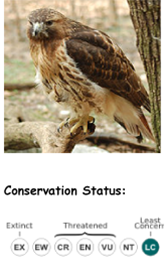Learn About Red-Tailed Hawk
The Red-tailed Hawk (Buteo jamaicensis) is a medium-sized bird of prey. It breeds throughout almost all North America from western Alaska and northern Canada to as far south as Panama and the West Indies, and is one of the most common hawk in North America.
This hawk gets his name from his uniformly brick-red tail. Although, the tail of the immature Red-tailed Hawk is patterned with numerous darker bars.
It typically weighs from 690 to 1600 grams (1.5 to 3.5 pounds) and measuring 45–65 cm in length, with a wingspan from 110 to 145 cm. The Red-tailed Hawk displays sexual dimorphism in size, as females are about 25% heavier than males.
The Red-tailed Hawk occupies a wide range of habitats and altitudes, including deserts, grasslands, coniferous and deciduous forests, tropical rainforests, agricultural fields and urban areas. It lives throughout the North American continent, except in areas of unbroken forest or the high arctic. It is legally protected in Canada, Mexico and the United States by the Migratory Bird Treaty Act.
Because they are so common and easily trained as capable hunters, Red-tailed hawks are very often used for falconry.
The Red-tailed Hawk also has significance in Native American culture. Its feathers are considered sacred by some tribes, and are used in religious ceremonies.
The cry of the Red-tailed Hawk is a hoarse, rasping scream, described as kree-eee-ar, which begins at a high pitch and slurs downward. This cry is often described as sounding similar to a steam whistle.
Because of its robust crispness, a certain recording of the cry of the Red-tailed Hawk is a cliché cinematic sound effect. This high, piercing scream is often featured in the background of adventure movies to give a sense of wilderness to the scene. However, the cry is often inaccurately used for the Bald Eagle, whose own vocalizations are quite different and less robust.
Like all birds of prey, the Red-tailed Hawk is carnivorous, and it is also an opportunistic feeder. Its diet is mainly small mammals, but it also includes birds and reptiles. Prey varies with regional and seasonal availability, but usually centers on small rodents. Additional preys include rabbits, snakes, waterfowl, bats, shrews, crustaceans, insects, rodents, and fish.
The Red-tailed Hawk hunts primarily from an elevated perch site, swooping down from a perch to seize prey, catching birds while flying, or pursuing prey on the ground from a low flight.
The Red-tailed Hawk reaches sexual maturity at two years of age. It is monogamous, mating with the same individual for many years. In general, the Red-tailed Hawk will only take a new mate when its original mate dies. The same nesting territory may be defended by the pair for years.
The pair constructs a stick nest in a large tree or on a cliff ledge or may nest on man-made structures. The nest is constructed of twigs, and lined with bark, pine needles, corn cobs, husks, stalks, aspen catkins, or other plant lining matter.
A clutch of 1 to 3 eggs is laid in March or April. Clutch size depends almost exclusively on the availability of prey for the adults. Eggs are laid approximately every other day. They are incubated primarily by female, with the male substituting when the female leaves to hunt or merely stretch her wings. The male brings most food to the female while she incubates. After 28 to 35 days, the eggs hatch over 2 to 4 days.

Scientific Classification:
- Kingdom: Animalia
- Phylum: Chordata
- Class: Aves
- Order: Falconiformes
- Family: Accipitridae
- Genus: Buteo
- Species: B. jamaicensis

References: *”Buteo jamaicensis”. Retrieved on 20 June, 2007. *Dewey, T. and D. Arnold. “Buteo jamaicensis”. Retrieved on 5 June, 2007. *”Red-tailed Hawk”. Bureau of Land Management. Retrieved on June 6, 2007. *”Buteo jamaicensis”. U.S. Geological Survey. Retrieved on 5 June, 2007. *”Buteo jamaicensis”. ITIS. Retrieved on June 10, 2007. *Tesky, Julie L.. “Buteo jamaicensis”. U.S. Department of Agriculture. Retrieved on June 10, 2007. *Howell, Steve N. G.;Sophie Webb (1995). A Guide to the Birds of Mexico and Northern Central America. Oxford University Press. *Garrigues, Jeff. “Biogeography of Red-tailed hawk”. San Francisco State University Dept of Geography. Retrieved 28 June, 2007. *”Red-tailed Hawk”. Sky-hunters.org. Retrieved on 16 June, 2007. *Geist, Bill. “In Love With A Hawk”. CBS. Retrieved on 17 June, 2007. *Day, Leslie. “The City Naturalist – Red Tailed Hawk”. 79th Street Boat Basin Flora and Fauna Society. Retrieved on 17 June, 2007. *”Red-Tailed Hawk”. Oregon Zoo. Retrieved on 16 June, 2007. *”Red-tailed Hawk – Buteo jamaicensis”. The Hawk Conservancy Trust. Retrieved on 5 June, 2007. *Terres, John K. (1980). The Audubon Society Encyclopedia of North American Birds. New York, NY: Knopf. pp. 1109. *”Buteo jamaicensis”. Oiseaux.net. Retrieved on 7 June, 2007. *”[http://www.fws.gov/policy/library/05-2378.html Migratory Bird Permits; Changes in the Regulations Governing Falconry; Notice of Intent To Prepare an Environmental Assessment for Falconry and Raptor Propagation Activities; Proposed Rule and Notice]”. Department of the Interior: Fish and Wildlife Service. Retrieved on 14 June, 2007. *McGranaghan, Liam J. (2001). The Red-Tailed Hawk: A Complete Guide to Training and Hunting North America’s Most Versatile Game Hawk.. Western Sporting Publications. pp. 181. *Collier, Julie. “The Sacred Messengers”. Mashantucket Pequot Museum. Retrieved on 20 June, 2007. *”TITLE 50–Wildlife and Fisheries”. Electronic Code of Federal Regulations (e-CFR). Retrieved on 20 June, 2007. *Cook, Stephen. “Feather Law”. Mashantucket Pequot Museum. Retrieved on 20 June, 2007.

